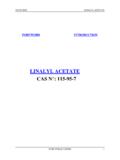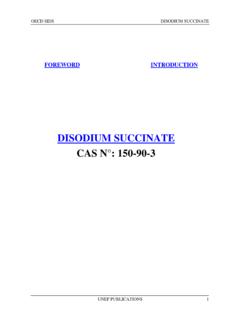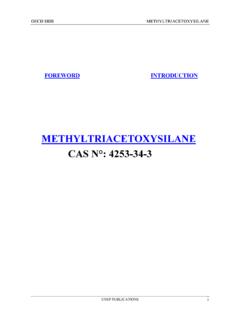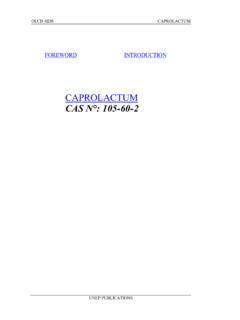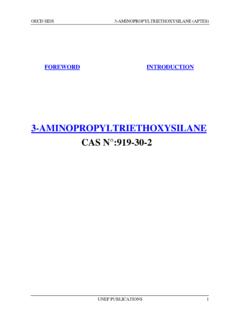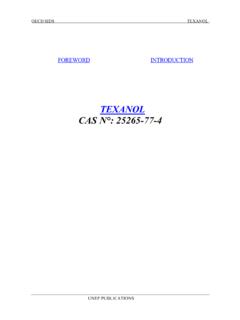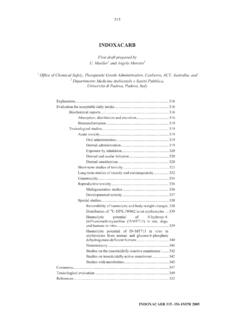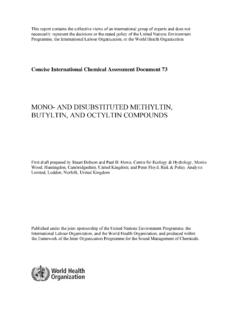Transcription of GLYOXAL CAS N°: 107-22-2 - INCHEM
1 OECD sids GLYOXAL . FOREWORD INTRODUCTION. GLYOXAL . CAS N : 107-22-2 . UNEP PUBLICATIONS. OECD sids GLYOXAL . sids INITIAL ASSESSMENT PROFILE. CAS No. 107-22-2 . Chemical Name GLYOXAL Structural Formula HC(=O)-C(=O)H. RECOMMENDATIONS. Human Health: The chemical is a candidate for further work. Environment: The chemical is currently of low priority for further work. SUMMARY CONCLUSIONS OF THE SIAR. Human Health The acute toxicity of GLYOXAL ranged from low to harmful in animal experiments performed with different species, depending on the active ingredient concentration of the tested product. GLYOXAL 40% has a moderate toxicity by the oral route, a low toxicity by the dermal route and a moderate toxicity by inhalation.
2 GLYOXAL causes slight to definite skin irritations depending on the exposure duration. Irritations up to necrotic changes have been described on the rabbit eye. It acts as a sensitizer to the skin of guinea pigs and humans. In a subacute inhalation study on rats for 29 days, a 40% GLYOXAL aerosol concentration of 10 and 2 mg/m3 results in a minimum squamous metaplasia of the epiglottal epithelium in the larynx. A. NOEL of mg/m3 is given for local effects and of > 10 mg/m3 for the systemic toxicity. In a 28. day oral study in rats, a NOEL of 100 mg/kg bw/d (40% GLYOXAL ) was determined. A dose related decrease of the water, food consumption and body weight were noted at 300 mg/kg and 1000.
3 Mg/kg. Variations of some haematological and blood parameters occurred at these doses. No macrocopic and microscopic pathological findings were seen that were considered to be compound related. In a 90d feeding study in rats, GLYOXAL in daily doses of ca. 30 to 250 mg/kg bw/d is tolerated without clinical, macroscopic and histopathological changes. A temporary reduced body weight gain and an increase of the relative liver and kidney weights, without any histopathological correlation, have been observed only in the males of the highest dose group. The NOEL is ca. 125 mg/kg bw/d related to 40% GLYOXAL . In 90-d drinking water studies with male rats with daily doses of ca. 140, 290 and 370 mg/kg bw/d, a decreased food and water intake as well as retarded body weight gain was found in the highest dose group.
4 The glyoxalase activities in the liver, kidney and erythrocytes are increased, while the aspartate aminotransferase activity, the alanine aminotransferase and lactate dehydrogenase activities as well as the albumin and total protein value are also determined in the low dose group. The LOEL lies at 107 mg/kg bw/d related to pure GLYOXAL . Overall, a NOEL of 100 mg/kg bw/d related to 40% GLYOXAL (40. mg/kg bw/d related to active ingredient) can be retained for repeated dose toxicity. GLYOXAL is shown to be mutagenic in in vitro genotoxicity studies in prokaryotes and eukaryotes. In vivo, GLYOXAL is proven to be negative in the micronucleus test on the mouse after oral administration.
5 On Drosophilia melanogaster, GLYOXAL is proven to be negative in the sex-linked 124 UNEP Publications OECD sids GLYOXAL . recessive-lethal test, in the dominant-lethal test and in the studies on the reciprocal translocation and on the loss of sex chromosomes. Chromosome aberrations in the duodenum, testes and spleen are described in an older, only insufficiently documented study after subcutaneous administration to rats. After oral administration to the rat, a significant increase of the unscheduled DNA synthesis is found in the pyloric mucosa, but not in primary hepatocytes, as well as an increase of DNA single-strand breaks in the liver and in the pyloric mucosa. These findings indicate that GLYOXAL reacts at the point of entry (the stomach) and immediately downstream (the liver), but not in more remote organs.
6 No dose-dependant effects were found on reproductive organs in repeated dose studies up to a dose of approx. 300 mg/kg bw/d (related to the active ingredient). Furthermore, a NOAEL of 125. mg/kg bw/d (related to the active ingredient) could be derived for prenatal development toxicity and of 25 mg/kg bw/d for maternal toxicity. No carcinogenic effect is detected in mice after dermal application of GLYOXAL over the entire life span. GLYOXAL possesses no tumor initiating effect after the dermal administration to mice After oral administration, GLYOXAL exhibits local tumor promoting properties in the mucosa of the forestomach of the rat (tissue not existing in other species or man).
7 In a liver promotion model on the rat, no indications were found for a promoting effect of GLYOXAL through systemic action. Finally, GLYOXAL is a metabolite of ethylene glycol and there are two negative carcinogenic studies on ethylene glycol (rats and mice). Environment GLYOXAL is not volatile and is not expected to accumulate in biota or soil/sediment. It is clearly readily biodegradable. In short-term tests with fish, daphnids and algae the following results were found: Pimephales promelas: 96 h-LC50 = 215 mg/l; Daphnia magna: 48h-EC50 = 404 mg/l; Scenedesmus subspicatus: 96h-EC50 > 500 mg/l. With an assessment factor of 1000 a PNEC aqua of 215 g/l can be calculated from the LC50 for fish (The results refer to the 40% aqueous solution).
8 For the active ingredient, the results are Pimephales promelas: 96 h-LC50 = 86 mg/l; Daphnia magna: 48h-EC50 = 161 mg/l; Scenedesmus subspicatus: 96h-EC50 > 200 mg/l; PNEC = 86 g/l). Exposure The worldwide production volume of GLYOXAL is estimated to be approx. 120000 to 170000 t/a. GLYOXAL is commercialized as a 40% aqueous solution. GLYOXAL is mainly used as a chemical intermediate and also for a small part as an active ingredient in disinfectant products in preparation with other components (formaldehyde, glutaraldehyde, quaternary ammonium). NATURE OF FURTHER WORK RECOMMENDED. Human health: Taking into account the skin irritation, the skin sensitising properties and the genotoxic potential and, based on the use pattern of GLYOXAL , a detailed risk assessment would be necessary.
9 Especially the risks based on the exposure from open uses ( as a disinfectant). should be evaluated. Environment: No further work is necessary UNEP Publications 125. OECD sids GLYOXAL . sids SUMMARY. CAS-NO.: 107-22-2 PROTOCOL RESULTS. PHYSICAL CHEMICAL. Melting Point 40% aq. sol. NA -14 C. Anhydrous * NA 15 C. Boiling Point 40% aq. sol. NA 104 C (at kPa). Anhydrous * NA C (at kPa). Density 40% aq. sol. NA 1270 kg/m3. Anhydrous * NA 1140 kg/m3. Vapour Pressure Anhydrous * NA < at 20 C. 40% NA 1800 Pa at 20 C. Partition Coefficient (Log Pow) Anhydrous * calculated - A Water solubility NA miscible at 20 C. ENVIRONMENTAL FATE /. BIODEGRADATION. Photodegradation calc. (Atkinson) In air T1/2 = hour Transport and Distribution calculated In air %.
10 (fugacity In water 100 %. level 1 type) In sediment %. In soil %. In biota %. Koc HPLC (40% aqueous Koc = l/kg solution). Biodegradation OECD 301 readily biodegradable (several tests). OECD 303 82% elimination after 6 days * for information only, anhydrous GLYOXAL is not stable and is not marketed 126 UNEP Publications OECD sids GLYOXAL . CAS-NO.: 107-22-2 SPECIES PROTOCOL RESULTS. ECOTOXICOLOGY. acute/prolonged toxicity to fish Pimephales US-EPA LC50 (96 hr) = 215 mg/l promelas ( 86 mg/l related to active substance). acute/prolonged toxicity to aquatic Daphnia magna 79/831/EEC, EC50 (48 hr) = 404 mg/l invertebrates (daphnia) ( 162 mg/l related to active substance). toxicity to aquatic plants Scenedesmus UBA EC50 (96 hr) > 500 mg/l e.
